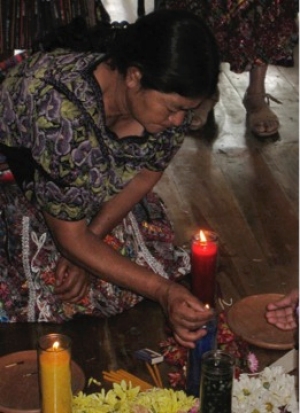Creative Resources in Conflict and Post-Conflict Contexts
Exploring the contributions of the creative arts and embodied practices and beliefs to truth and justice seeking processes in Guatemala and beyond, led by Professor M. Brinton Lykes and Professor Alison Crosby (York University, Canada)
This project was designed to explore the transformative potential of creative methodologies, including the creative arts (drawing, collage, storytelling), embodied practices (massage, human sculptures, role plays, theatre), and beliefs and practices from the Mayan cosmovision (ceremonies and rituals), in psychosocial and feminist accompaniment processes that seek to liberate the potential of Mayan women in Guatemala to act on their own behalf as protagonists of their lives. It is situated within a long tradition of deploying creative approaches within Guatemala (Grupo de Mujeres Maya Kaqla 2006; http://www.cajaludica.org/; Women of Photovoice & Lykes, 2000; Lykes, 1994, 2001), healing practices within indigenous communities and First Nations in other parts of the world (Castellano, 2006; Archibald & Dewar, 2010), and in the wake of contemporary genocides and state-sponsored violence (Taylor, 2003; www.yuyachkani.org; Lykes et al., 1994).

Mayan Rituals as One Resource for Healing
Specifically, we document and analyze the use and impact of creative resources over several years within two distinct multi-year projects that have engaged Mayan women who are survivors of gross violations of human rights committed during the thirty-six year Guatemalan armed conflict, including sexual violence, massacres and massive displacements. The first project is now comprised of 53 women who have self-identified as survivors of sexual violence who in 2003 began receiving accompaniment and support to address their individual and collective psychosocial trauma in the wake of war, and participated in an explicitly feminist series of actions in support of their struggles for truth, justice and reparation (Fulchiron, Paz and Lopez 2009). In 2009, we began working with these women in a four-year feminist participatory action research project on gender and reparations in coordination with the National Union of Guatemalan Women (UNAMG). The second project began over two decades ago with Maya Ixil and K’iche’ women in the rural town of Chajul and its surrounding villages in the region of northern Quiché who also suffered gross violations of human rights and sexual violence during the war. Since 1991, Lykes has worked with these women in community-based psychosocial processes to seek truth-telling and justice and rethread local community in the wake of these violations (see Women of Photovoice & Lykes, 2000). It was explicitly focused on Mayan women’s rights and economic survival. Many of the participants had survived sexual violence, experiences which were revealed over the course of a multiple year process through oral histories told to each other in dyadic pairs.

